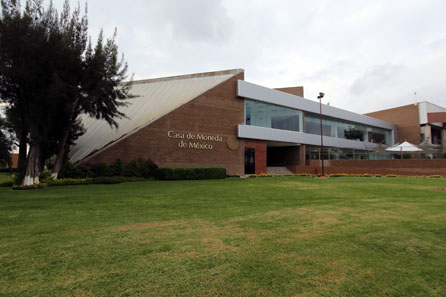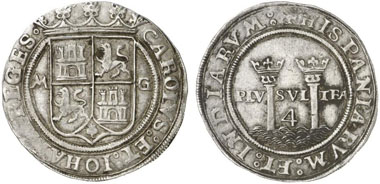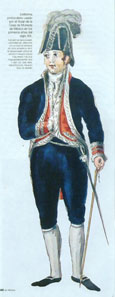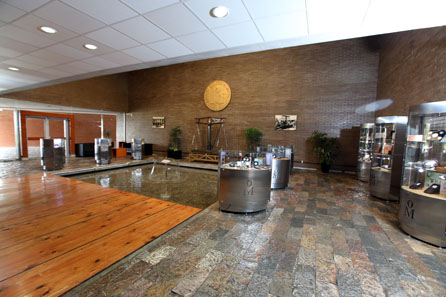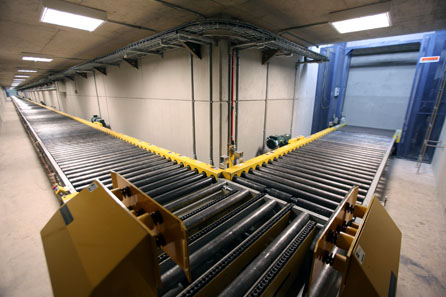December 11, 2012 – When you visit the Mexican Mint facility in San Luis Potosí nothing recalls to you the long history of this institution. But it was not only a recent fancy of producing far away from its historical roots. There is much more beneath.
The modern facility of the Mexican Mint in San Luis Potosí. Photo: Casa de Moneda.
The Mexican Mint was founded in 1535 quite soon after Columbus had discovered the New World. During the first years the Spaniards imported all the coins required for creating a market in the Viceroyalty of New Spain. However, soon they re-evaluated the situation. Their dominion was characterised by unlimited resources of silver which, of course, they shipped to Europe. Transporting the minted coins back was only a waste of time and material.
Charles V and Joanna of Castilia, 1504-1555. 4 Reales no year (1542/1555). The inscription refers to the unity of Spain and the dominion in the New World: “Carolus et Iohanna Reges Hispaniarum et Indiarum” (Charles and Joanna, Kings of the Spanish and Indian dominions) From Künker auction 217 (2012) 3366.
Hence, in 1535 after establishing the Vice-royalty the representative of Charles V King of Spain, Antonio de Mendoza, founded the Mexican Mint in the new capital Ciudad de México.
For a couple of times the workshop was transferred, but always it remained nearby the vice-royal palace. In the seventeenth and eighteenth century entrepreneurs rented the minting right. But eventually the government decided to control the process of minting itself.
Reconstruction of a roller coining machine, today to be found in Hall / Tyrol. Photo: KW.
In 1778 royal reforms decreed that the Mint should execute its work exclusively on order of the Ministry of Finance. At that point the mint had been modernized. Instead of hammering each metal strip by hand, coils were made by a rolling mill, a technical innovation coming from Hall in Tyrol. The coins, on the other hand, were struck by a screw press leading thus to results much higher in quality compared to the hammered coins.
One of the initiators of all these changes was Gerónimo Antonio Gil, one of the best coin engravers of his time. He gathered many students and establishing thus in the heart of the workshop an art college, the Real Academia de las Tres Nobles Artes de San Carlos.
The director of the mint in his uniform around 1810. Photo: Casa de Moneda.
The central workshop in Ciudad de México lost its important during Mexico’s War of Independence. Between 1810 and 1821 the central government was no longer able to control the country. Coin distribution all over the nation therefore became impossible. To cope with this situation the mint split its production between various workshops all over the country, one of them was San Luis Potosí. Here silver had been found since 1592, and so the new centre had been named after the French king and the most important centre of silver production, Potosi in Central Bolivia.
Today the visitor is received in a modern lobby in San Luis Potosí where they can admire the most recent products. Photo: Casa de Moneda.
In the 19th century the need for coins augmented enormously. Even though the mules operating the roller mill were replaced in 1840 by a steam engine, the Mexican mints were not able to strike enough money for the ambitious nation. Though, a part of the coin production was delegated to foreign mints like the US mint in Philadelphia.
In 1905 Mexico decided to employ a new technology in order to guarantee that all coins of the new Republic could be minted in the country: the steam engines were sent to the scrapyard, since the era of electricity had just began. It was a difficult time. New machines were purchased and the workers who had to operate them had to be trained. But after some years, finally, Mexico was no longer forced to rely on mints abroad to produce all its coins. And the electrical equipment was being used effectively until 1992.
In 1925 the Nationalbank Banco de México took over political control over the mint as in many other countries too. Since 1986 the mint has become an industrial entity being thus no longer part of the Ministry of Finance. The mint has to compete on the market since then.
A little insight in the new mint in San Luis Potosí. Photo: Casa de Moneda.
In 1992 the mint’s facility was transferred to San Luis Potosí after many years in Ciudad de México. Modern equipment, a new building and generous space has led to many award winning coins as for example during the Mint Directors Conferences. Like many other mints the Mexican Mint produces – beside of the circulation coins – medals not only on behalf of the Mexican Ministry of Finance but for foreign institutions as well.
In Mexico they are not only proud of their mint’s history but they commemorate their numismatic past in two splendid museums in Ciudad de México. But life goes on in San Potosí.
To learn more about the Mexican Mint, you may visit its website.




